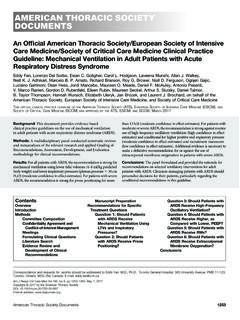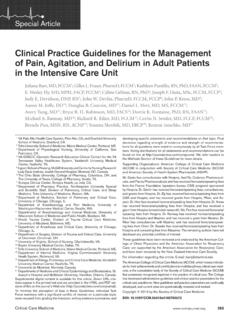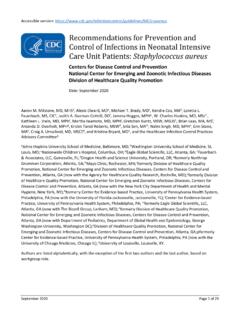Transcription of Primary Care in the US: A Chartbook of Facts and Statistics
1 Primary care in the United StatesA Chartbook of Facts and StatisticsPrimary care in the United States2 Prepared by: Robert Graham Center (RGC) 1133 Connecticut Avenue NW, Suite 1100 Washington, DC 20036 @TheGrahamCenterIBM-Watson Health (IBM) 75 Binney St Cambridge, MA 02142 American Board of Family medicine (ABFM) & affiliated Center for Professionalism & Value in Health care (CPV) 1016 16th Street NW, Suite 700 Washington, DC 20036 :Brian Antono, RGC Andrew Bazemore, ABFM/CPV Irene Dankwa-Mullan, IBM Judy George, IBM Anuradha Jetty, RGC Stephen Petterson, RGC Amol Rajmane, IBM Kyu Rhee, IBM Bedda L. Rosario, IBM Elisabeth Scheufele, IBM Joel Willis, ABFM/CPVA cknowledgements: Thanks to the many people who contributed to this report throughout its development at IBM, ABFM, and the Robert Graham Center.
2 IBM colleagues include: Sean Kennedy, Tim Bullock, Kay Miller, Amanda Mummert and Sarah February 2021 Suggested Citation:Willis J, Antono B, Bazemore A, Jetty A, Petterson S, George J, Rosario BL, Scheufele E, Rajmane A, Dankwa-Mullan I, Rhee K. The State of Primary care in the United States: A Chartbook of Facts and Statistics . October of contents04 Preface 06 Executive Summary07 I. Introduction08 Why Primary care ?09 Ecology of Medical care 10 II. First Contact11 Who Provides Primary care ? 11 Primary care Physicians12 Primary care Nurse Practitioners and Physician Assistants12 Age Distribution of Primary care Physicians13 Primary care Physicians by Gender13 Number of Graduates from Primary care Residencies14 Where is Primary care Provided?
3 14 Ratios of Primary care Professionals to Population 15 Primary care Physician to Population Ratios by State16 Primary care Physicians by Rural/Urban Geography16 Primary care Practices by Ownership18 III. Continuity19 Who Visits Primary care Practices?19 Office Visits to Physicians by Specialty20 Outpatient Visits to Primary care Physicians by Patient Age and Sex21 IV. Comprehensiveness22 What Medical Conditions do Primary care Physicians Address?22 Primary care Physicians Scope of Practice23 Primary care for Patients with Chronic Conditions23 Changes in Primary care Scope of Practice24 V. Coordination25 How Does care Coordination Function in Primary care ?
4 27 VI. Cost28 How Much Do We Spend on Primary care ?29 Expenditures for Primary Care30 Primary care Payment Sources30 Trends in Compensation for Primary care Providers 31 VII. Preventive care Visits32 Why Preventive care Visits? 33 Trend of Preventive care Visit Utilization34 Preventive care Visit Utilization, Stratified by Age and Sex35 Preventive care Visit Utilization, Regional Distribution36 Preventive care Visit Utilization, by Health Plan37 Patients with Preventive care Visits, Primary care and Non- Primary care Providers38 Trend of Average Total Cost of Preventive care Visit Utilization39 VIII. References42 Methods Appendix44 Description of Data SourcesPrimary care in the United States3 Preface As we launched this project in the summer of 2019, we could scarcely have imagined that just 12 months later, the United States ( ) would be beleaguered in a global pandemic by the coronavirus disease 2019 (COVID-19).
5 What is even more surprising is that we would submit a Chartbook for publication in the country facing the world s heaviest pandemic burden at that time, despite having the greatest per capita wealth and health care spending of any nation. The United States, home to 4% of the world s population, currently accounts for about a quarter of both the world s COVID-19 cases (4,000,000) and deaths (150,000).1,2 Such dismal figures coincide with an overly specialized, and highly fragmented health care system with a long history of underinvestment in both Primary care and public health. At this moment, the only certainty seems to be more uncertainty as we find ourselves coming to grips with a new normal.
6 Yet, as the current situation continues to evolve, the impact of COVID-19 will be felt far beyond its population-based effects on morbidity and mortality,3 with sequelae including:4 severely strained management of chronic disease,5 increase in and worsening of mental health,6,7 and associated effects,8 and exacerbation9 in disparity of an already existing and uneven provision of medical and health care services10 for vulnerable populations. Despite the challenges being endured during this pandemic, the practice of Primary care stands to play a significant role in the management of these issues, employing previously underutilized technology such as telehealth, and overcoming the financial and physical limitations imposed by the pandemic on a practice model built on routinely physician office-based patient care is not exempt from the strain facing so many sectors of the economy, and health care in particular.
7 Early convenience sampled surveys administered weekly to a cohort of over 700 Primary care clinicians (across 49 states) suggested they experienced extreme mental stress, increased morbidity and mortality among patients from pandemic-related constraints, resource loss (due to staff sickness and/or quarantine), and existential financial The means by which Primary care practices meet such challenges is evolving, but there is little doubt that the pandemic will leave an indelible mark on Primary care access, team-structure, size, and health care community has also experienced a transformation in clinical care delivery. After years of lamenting the limited use, and sluggish adoption of telehealth in Primary care ,12 the swift pivot and embrace of this platform by Primary care clinicians and patients alike to accommodate social distancing imperatives has been remarkable.
8 The demand and use of telehealth services has accelerated rapidly as new rules relaxed prior regulations, resulting in exponentially expanding access, billing, and A study by The Commonwealth Fund showed that as in-person visits dropped early in the pandemic, telemedicine visits briskly peaked to 14% of weekly visits through mid-April. By mid-June, telemedicine visits declined from its peak, but remained substantially higher than pre-COVID-19 Unfortunately, Primary care practices, that were unable to shift to virtual care , were forced to restrict certain services or to One model examining the financial impact of COVID-19 on Primary care practices estimates that $ billion is needed to neutralize revenue losses Even assuming a rapid ramp up of telemedicine services to offset losses of in-person visits, a variety of scenarios estimates Primary care practices losing over $65,000 per full-time equivalent (FTE)
9 Physician from current fee-for-service payment An example in Virginia demonstrated that a network of 12 Primary care offices and 500 employees experienced 50% losses in patient volume and 60% losses in revenue by May 2020 resulting in furloughs of 50 employees, reduced staff Primary care Amidst a Generational PandemicPrimary care in the United States4hours, and significant pay cuts to clinician Despite such financial challenges, clinicians and Primary care practices around the country have fought hard to keep their doors As it currently stands, the direct costs of COVID-19 illustrate a disproportionate burden on minority communities.
10 Black, Indigenous, Latinx, and other people of color are facing higher rates of hospitalization or death from COVID-19 compared to non-Hispanic white People of color have also suffered from long-standing systemic health and social inequities leading to higher rates of chronic conditions that worsen the effects of In addition to direct costs of COVID-19 are indirect ones, or COVID collateral. These include but are not limited to missed preventive care needs, depression, anxiety, substance misuse, and domestic violence increasingly witnessed by Primary care practices throughout the Ultimately, the risks of significant morbidity and mortality from these sequelae may far outweigh the enormous damage by the initial wave of COVID-19.





